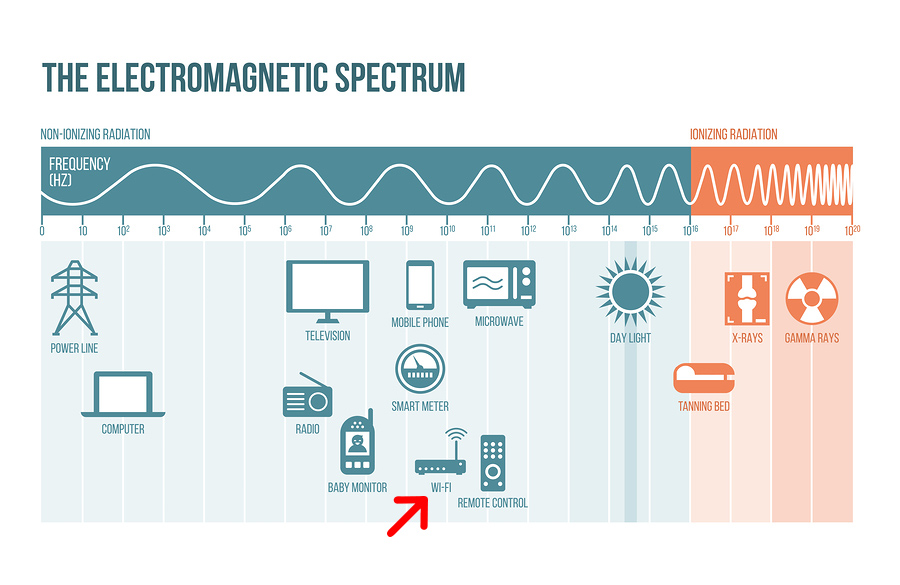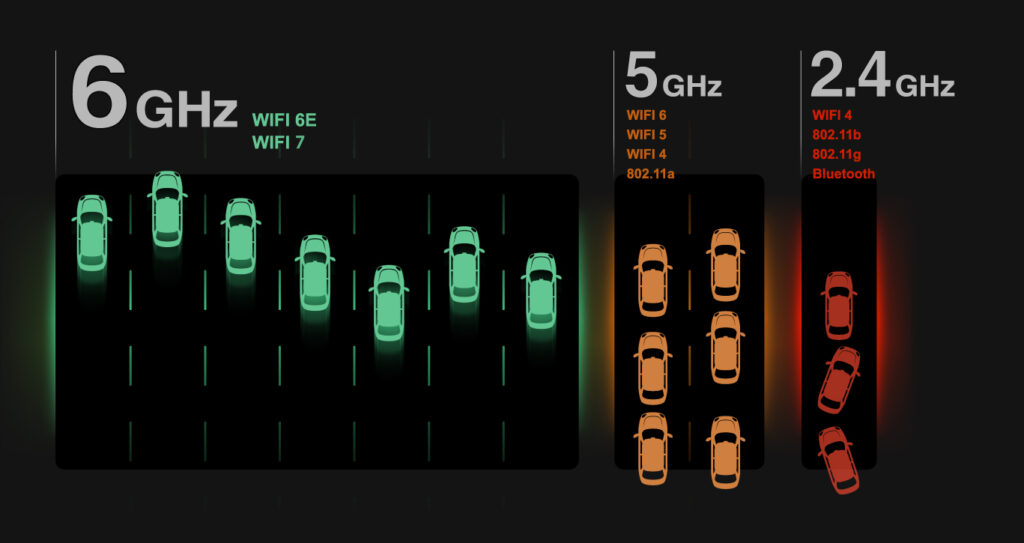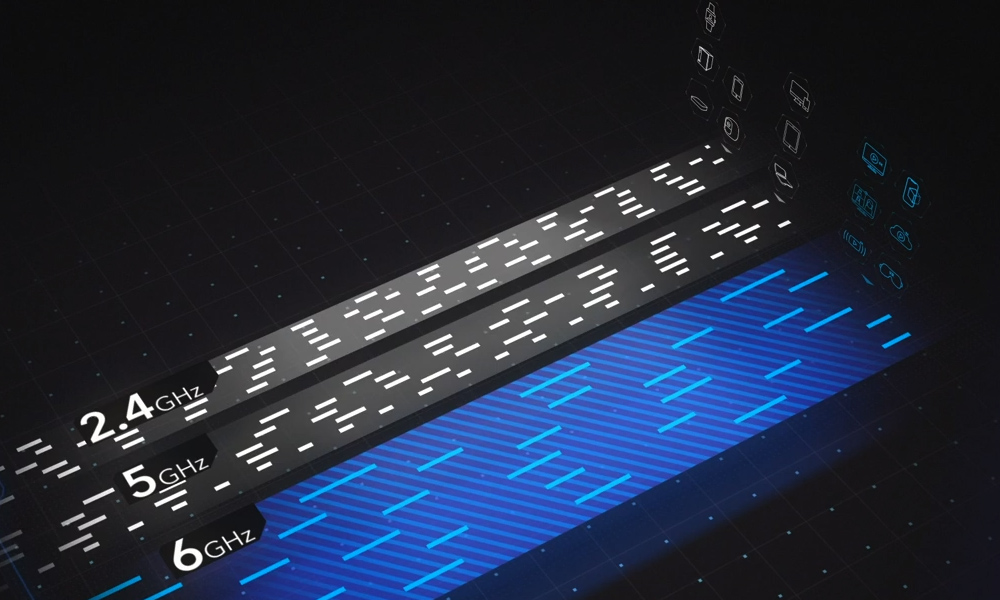If you’ve been shopping around for a new WiFi router, you might have noticed a lot of them are dual-band, tri-band, or quad-band. That means they operate across multiple “WiFi frequency bands.” But what are WiFi bands, and which one should you connect to? Here’s everything you need to know about the difference between 2.4 GHz, 5 GHz, and 6 GHz bands and how to connect to the right one.
What Are WiFi Bands?
WiFi routers use radio waves to transmit data to your connected devices wirelessly. These radio waves are divided into three “frequency bands” known as: 2.4 GHz (gigahertz) 5 GHz, and 6 GHz. Each band has its own unique properties, and switching to a different band could instantly change your network’s speed, range, and more.


2.4 GHz Vs 5 GHz Vs 6 GHz
If you think of each WiFi band as a separate highway, the 2.4 GHz band would be the oldest and slowest, while the 5 GHz band would be faster with more lanes. However, the 5 GHz highway has restricted lanes, while the new 6 GHz superhighway has no restricted lanes and very little traffic from other devices yet.


What Is the 2.4 GHz WiFi Band?
In 1985, the Federal Communications Commission (FCC) opened a small amount of radio spectrum for “unlicensed” use. In 1999, the first WiFi devices that ever came to market all used the 2.4 GHz spectrum to connect devices to the internet wirelessly. While this WiFi band is still used today, it is generally overcrowded and slow.
What Is the 5 GHz WiFi Band?
While the 5 GHz band is almost as old as the 2.4 GHz band, it provides more than five times the spectrum. However, much of the 5 GHz spectrum is also used by government radar systems and satellite communications, and only a fraction of the total spectrum is unrestricted and always available.
What Is the 6 GHz WiFi Band?
The new 6 GHz band was recently opened by the FCC in 2020, in order to prevent the “devastating congestion in our existing networks,” according to FCC commissioner Michael O’Rielly. This new band more than doubles the existing WiFi spectrum and allows for the fastest possible connections.
2.4 GHz Vs 5 GHz Vs 6 GHz: Speed
With a new WiFi 7 router, you can theoretically achieve speeds up to 5.8 Gbps (gigabits per second) on the 6GHz band. With a WiFi 6 router, you can theoretically achieve speeds up to 2.4 Gbps on the 5 GHz band. The 2.4 GHz band can achieve speeds up to 100 Mbps (megabits per second), depending on your router.
Read More: What is WiFi 7?
So, to achieve the fastest WiFi speeds, you should connect a device to the 6 GHz band. If you can’t access the 6 GHz band on a device, you’ll get the fastest speeds by connecting to the 5 GHz band instead. The 2.4 GHz band is the slowest, and you should only reserve it for your less-important devices.
Read More: 20 ways to boost your WiFi speed
2.4 GHz Vs 5 GHz Vs 6 GHz: Spectrum
The 2.4 GHz WiFi band provides around 80 MHz of spectrum with only three non-overlapping channels to choose from. The 5 GHz band offers a total of 500 MHz of spectrum (but only 180 MHz is unrestricted) with 25 channels. And the new 6 GHz band offers 1,200 MHz of unrestricted spectrum with 59 channels.
If you imagine WiFi bands as highways, channels would be like the lanes on those highways. The more channels a band has, the less congested they will get. Plus, wider channels allow your router to send more data to your devices.
So, if you want to connect high-bandwidth devices, like smartphones, computers, and VR headsets, you should use the widest band. Currently, that would be the three new 320 MHz channels on the 6 GHz band. These ultrawide channels are also designed to provide enough bandwidth for future devices and technologies.
Read More: How to change the channel on your WiFi router
Since the entire 6 GHz spectrum is unrestricted, you won’t have to deal with DFS (Dynamic Frequency Selection) channels. That means the 6 GHz band actually offers five times as much unrestricted spectrum as both previous bands combined, making it one of the biggest upgrades to WiFi in decades.
DFS vs AFC
In order to make so much spectrum available without causing interference for radar systems and satellites, the FCC requires all 6 GHz WiFi routers to use a new technology called AFC (Automated Frequency Coordination). Unlike DFS, the AFC system won’t kick your devices off a channel randomly, and you should be able to connect to any channel, as long as you are using low-power, indoor devices.
2.4 GHz Vs 5 GHz Vs 6 GHz: Range
While the 2.4 GHz band is the oldest and slowest, it does provide the widest coverage. Since 2.4 GHz signals use wider radio frequencies, they won’t be able to carry as much data, but they can travel farther. On the other hand, the 5 GHz and 6 GHz bands use shorter frequencies, which carry more data over a shorter range.
So, if you’re connecting devices far away from your router, you might get a better signal when using the 2.4 GHz band. This makes the 2.4 GHz band perfect for connecting all your smart devices, like smart cameras and video doorbells. Not only will they get a stronger signal from a greater distance, but they also won’t create interference on the faster bands.
How to Change WiFi Bands
With most WiFi routers, you can easily change which band you are connected to by changing WiFi networks. To do this, go into your device’s settings and navigate to the WiFi section. Then look at your WiFi network name: if it ends in “2G,” it will be on the 2.4 GHz band; if it ends in “5G,” it will be on the 5 GHz band.
If you don’t see the WiFi band listed at the end of your network, or you have ever renamed your WiFi networks manually, you will need to log into your router to find out which band your networks are using. There are also some routers that will use multiple WiFi bands in the same network.
Read More: How to log into your router and change your WiFi name and password
In order to connect to the 6 GHz band, you’ll need a router that supports the WiFi 6E or WiFi 7 standards. However, if you have a mesh WiFi system, the 6 GHz band might be reserved for a “wireless backhaul.” It’s also important to note that you’ll only be able to connect devices to the 6 GHz band if they are WiFi 6E or WiFi 7 compatible.


